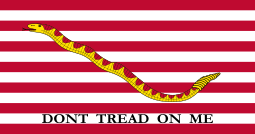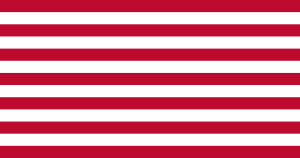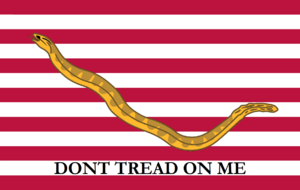First Navy Jack facts for kids

The "First Navy Jack", currently flown only by the oldest warship in the U.S. Navy.
|
|
| Name | The First Navy Jack |
|---|---|
| Proportion | 2:1 |
| Adopted | October 13, 1975 (as U.S. naval jack) August 18, 1980 (for oldest U.S. warships) September 11, 2002 (as U.S. naval jack) |
| Relinquished | December 31, 1976 (as U.S. naval jack) June 4, 2019 (as U.S. naval jack) |
| Design | 13 horizontal stripes of alternating red and white, charged with a rattlesnake and inscribed on the lowest white stripe: "DONT [sic] TREAD ON ME". |
The First Navy Jack is a special flag used by the U.S. Navy. It was the official naval jack (a flag flown from the front of a ship) for two periods: from 1975 to 1976, and again from 2002 to 2019. This flag was flown on U.S. Navy ships when they were docked or anchored.
Today, the First Navy Jack is only flown by the oldest active warship in the U.S. Navy. The flag's design is thought to be similar to the first U.S. naval jack flown after America became independent. However, historical records don't fully support this idea.
On June 4, 2019, the First Navy Jack was replaced by the U.S. Union Jack. The Union Jack has white stars on a blue background. This change was ordered by the Chief of Naval Operations, who is the top officer in the U.S. Navy.
Contents
In late 1775, the first ships of the Continental Navy were getting ready. Commodore Esek Hopkins told his ships to fly a "striped" jack and ensign. We don't know exactly what these flags looked like.
Since about 1880, this jack has usually been shown with thirteen red and white stripes. It also features an uncoiled rattlesnake and the words "Dont Tread on Me" (which means "Don't step on me"). This design appeared in a book about the U.S. flag by Admiral George Henry Preble. However, recent studies show that this specific design probably never existed. It was likely a mistake from the 1800s.
In 1778, John Adams and Benjamin Franklin wrote a letter. They thanked the Ambassador of the Kingdom of Sicily for letting American ships into Sicilian ports. In the letter, they described the new flag of the colonies. They also mentioned a flag from "South Carolina" with a rattlesnake in the middle of thirteen stripes.
The Rattlesnake: A Symbol of American Resistance
The rattlesnake has long been a symbol in the American colonies. It represented resistance and defiance against the British Crown. The phrase "Don't Tread on Me" might have been created during the American Revolutionary War. It's a variation of an older image.
A political cartoon by Benjamin Franklin in 1754 showed a snake cut into pieces. Each piece was labeled with the name of a colony. The cartoon had the words "Join, or Die". This cartoon was about the Albany Congress, a meeting of colonial leaders.
The Timber rattlesnake is especially important to the American Revolution. Its rattle has thirteen layers, which stands for the original Thirteen Colonies. Also, the snake only strikes when it feels threatened. This characteristic is shown by the phrase "Don't tread on me" (see Gadsden flag).
Usually, the rattlesnake on the flag has red scales on its back. But some versions have shown the snake as all gold.

Modern use of the flag began in 1976. That year, the United States celebrated its 200th birthday. All U.S. Navy ships were told to fly the First Navy Jack for that year. They flew it when they were docked or anchored. After that year, commanding officers could choose to keep flying it.
Before and after 1976, the standard flag was the fifty-star Union Jack. In 1980, Secretary of the Navy Edward Hidalgo made a new rule. He said that the warship or support vessel with the longest active service should display the First Navy Jack. It would fly this flag until it was taken out of service.
The flag's status changed again on May 31, 2002. Navy Secretary Gordon England ordered all U.S. Navy warships and support ships to fly the First Naval Jack. This was a "temporary change" during the Global War on Terrorism. The idea came from a suggestion after the 9/11 attacks. Most ships made this change on September 11, 2002, the first anniversary of the attacks.
Not all U.S. vessels flew the flag. This included ships of the U.S. Coast Guard and vessels of the National Oceanic and Atmospheric Administration. Also, U.S. Navy ships mostly staffed by civilians did not fly it.
On February 21, 2019, Admiral John Richardson, the Chief of Naval Operations, announced a change. The blue Union Jack would return to almost all U.S. Navy warships. He brought back the 1980 rule. This means the First Navy Jack is now only for the warship with the longest active service. This rule does not include the USS Constitution. While it's the oldest ship, it's only used for ceremonies.
Here are some of the U.S. Navy vessels that have held the honor of being the "oldest ship" in the fleet:
| Ship name | Type | Commission date | Decommission date | Years as oldest | Age | Homeport | Fate |
|---|---|---|---|---|---|---|---|
| USS Dixie (AD-14) | Destroyer tender | April 25, 1940 | June 15, 1982 | 1981–1982 | 42 | Subic Bay, Philippines | Scrapped |
| USS Prairie (AD-15) | Destroyer tender | August 5, 1940 | March 26, 1993 | 1982–1993 | 52 | N/A | Scrapped |
| USS Orion (AS-18) | Submarine tender | September 30, 1943 | September 3, 1993 | 1993 | 50 | Newport, Rhode Island | Scrapped |
| USS Sierra (AD-18) | Destroyer tender | March 20, 1944 | October 15, 1993 | 1993 | 49 | Charleston, South Carolina | Scrapped |
| USS Jason (AR-8) | Repair ship | June 19, 1944 | June 24, 1995 | 1995 | 51 | Pearl Harbor, Hawaii San Diego, California |
Scrapped |
| USS Mauna Kea (AE-22) | Ammunition ship | March 30, 1957 | June 30, 1995 | 1995 | 38 | Concord, California | Sunk as target |
| USS Independence (CV-62) | Aircraft carrier | January 10, 1959 | September 30, 1998 | 1995–1998 | 39 | Naval Station Norfolk, Virginia San Diego, California Yokosuka, Japan |
Scrapped |
| USS Kitty Hawk (CV-63) | Aircraft carrier | April 29, 1961 | May 12, 2009 | 1998–2009 | 48 | Bremerton, Washington | Awaiting scrapping |
| USS Enterprise (CVN-65) | Aircraft carrier | November 25, 1961 | December 1, 2012 | 2009–2012 | 51 | Naval Station Norfolk, Virginia | Awaiting scrapping |
| USS Denver (LPD-9) | Amphibious transport dock | October 26, 1968 | August 14, 2014 | 2012–2014 | 45 | Sasebo, Japan | Decommissioned |
| USS Blue Ridge (LCC-19) | Amphibious command ship | November 14, 1970 | N/A | 2014–present | 48 | Yokosuka, Japan | Active |
Since September 11, 2002, U.S. Navy bases on land can also fly the First Navy Jack. They can do this from flagpoles that have multiple ropes, especially when the United States ensign is also flown.
Sailors and naval officers can also wear the First Navy Jack as a patch. It can be worn on flight suits and some versions of the Navy Working Uniform (NWU). This includes sailors wearing the Army Combat Uniform (ACU) when they are working with Army units. The patch is usually worn on the opposite sleeve from the U.S. flag.
The First Navy Jack, along with the Serapis flag, is also part of the crest for the Arleigh Burke-class guided missile destroyer USS John Paul Jones.
During the War in Afghanistan, U.S. Navy sailors and officers working with the International Security Assistance Force (ISAF) could wear the First Navy Jack. They wore it on their MultiCam-patterned Army Combat Uniform (ACU) on the right sleeve, below the U.S. flag.
Non-Military Uses of the Flag
Like other snake flags, the First Navy Jack has been used by people outside the Navy. They use it for protests or to remember important events. For example, people against a smoking ban in Franklin, Indiana, fly Navy Jacks outside their homes. A First Navy Jack flag was also placed at a memorial after the Boston Marathon bombing.



